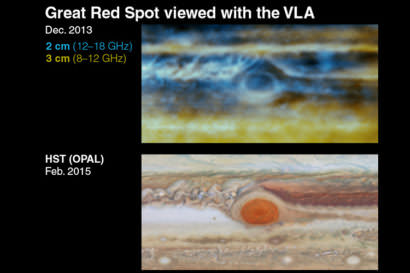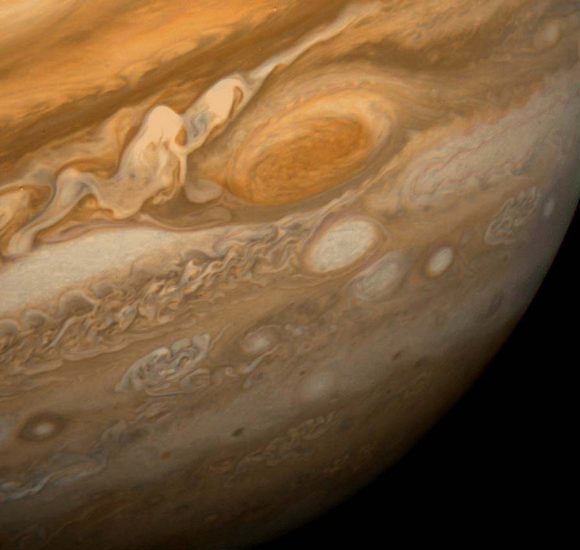Jupiter’s Great Red Spot is easily one of the most iconic images in our Solar System, next to Saturn’s rings. The Great Red Spot and the cloud bands that surround it are easily seen with a backyard telescope. But much of what goes on behind the scenes on Jupiter has remained hidden.
When the Juno spacecraft arrives at Jupiter in about a month from now, we will be gifted some spectacular images from the cameras aboard that craft. To whet our appetites until then, astronomers using the Karl G. Jansky Very Large Array in New Mexico have created a detailed radio map of the gas giant. By using the ‘scope to peer 100 km past the cloud tops, the team has brought into view a mostly unexplored region of Jupiter’s atmosphere.
The team of researchers from UC Berkeley used the updated capabilities of the VLA to do this work. The VLA had its sensitivity improved by a factor of ten. “These Jupiter maps really show the power of the upgrades to the VLA,” said Bryan Butler, a member of the team and staff astronomer at the National Radio Astronomy Observatory in Socorro, New Mexico.
In the video below, two overlaid maps alternate back and forth. One is optical and the other is a radio image. Together, the two show some of the atmospheric activity that takes place under the cloud tops.
The team measured Jupiter’s radio emissions in wavelengths that pass through clouds. That allowed them to see 100 km (60 miles) deep into the atmosphere. This allowed them to not only determine the quantity and depth of ammonia in the atmosphere, but also to learn something about how Jupiter‘s internal heat source drives global circulation and cloud formation.
“We in essence created a three-dimensional picture of ammonia gas in Jupiter’s atmosphere, which reveals upward and downward motions within the turbulent atmosphere,” said principal author Imke de Pater, a UC Berkeley professor of astronomy.
These results will also help shed light on how other gas giants behave. Not just for Saturn, Uranus, and Neptune, but for all the gas giant exoplanets that have been discovered. de Pater said that the map bears a striking resemblance to visible-light images taken by amateur astronomers and the Hubble Space Telescope.

In the radio map, ammonia-rich gases are shown rising and forming into the upper cloud layers. The clouds are easily seen from Earth-bound telescopes. Ammonia-poor air is also shown sinking into the planet’s atmosphere. Hotspots, which appear bright in radio and thermal images of Jupiter, are regions of less ammonia that encircle the planet north of the equator. In between those hotspots, rich upwellings deliver ammonia from deeper in the atmosphere.
“With radio, we can peer through the clouds and see that those hotspots are interleaved with plumes of ammonia rising from deep in the planet, tracing the vertical undulations of an equatorial wave system,” said UC Berkeley research astronomer Michael Wong. Very nice.
“We now see high ammonia levels like those detected by Galileo from over 100 kilometers deep, where the pressure is about eight times Earth’s atmospheric pressure, all the way up to the cloud condensation levels,” de Pater said.

This is fascinating stuff, and not just because it’s visually stunning. What this team is doing with the improved VLA dovetails nicely with what Juno will be doing when it gets set up in its orbit around Jupiter. One of Juno’s aims is to use microwaves to measure the water content in the atmosphere, in the same way that the VLA was used to measure ammonia.
In fact, the team will be pointing the VLA at Jupiter again, at the same time as Juno is detecting water. “Maps like ours can help put their data into the bigger picture of what’s happening in Jupiter’s atmosphere,” de Pater said.
The team was able to model the atmosphere by observing it over the entire frequency range between 4 and 18 gigahertz (1.7 – 7 centimeter wavelength), which enabled them to carefully model the atmosphere, according to David DeBoer, a research astronomer with UC Berkeley’s Radio Astronomy Laboratory.
“We now see fine structure in the 12 to 18 gigahertz band, much like we see in the visible, especially near the Great Red Spot, where we see a lot of little curly features,” Wong said. “Those trace really complex upwelling and downwelling motions there.”
The detailed observations the team obtained also help resolve a discrepancy in ammonia measurements in Jupiter’s atmosphere. In 1995, the Galileo probe measured ammonia at 4.5 times greater than the Sun, when it plunged through the atmosphere. VLA measurements prior to 2004 showed much less ammonia than that.
Study co-author Robert Sault, of the University of Melbourne in Australia, explained how this latest imaging solved that mystery. ““Jupiter’s rotation once every 10 hours usually blurs radio maps, because these maps take many hours to observe. But we have developed a technique to prevent this and so avoid confusing together the upwelling and downwelling ammonia flows, which had led to the earlier underestimate.”
Overall, it’s exciting times for studying Jupiter. The Juno mission promises to be as full of surprises as New Horizons was (we hope.)
Universe Today has covered the Juno mission, including an interview with the Principal Investigator, Scott Bolton.
The team’s paper is published in the journal Science, here.


Come on JUNO!! When’s the orbital the insertion date?